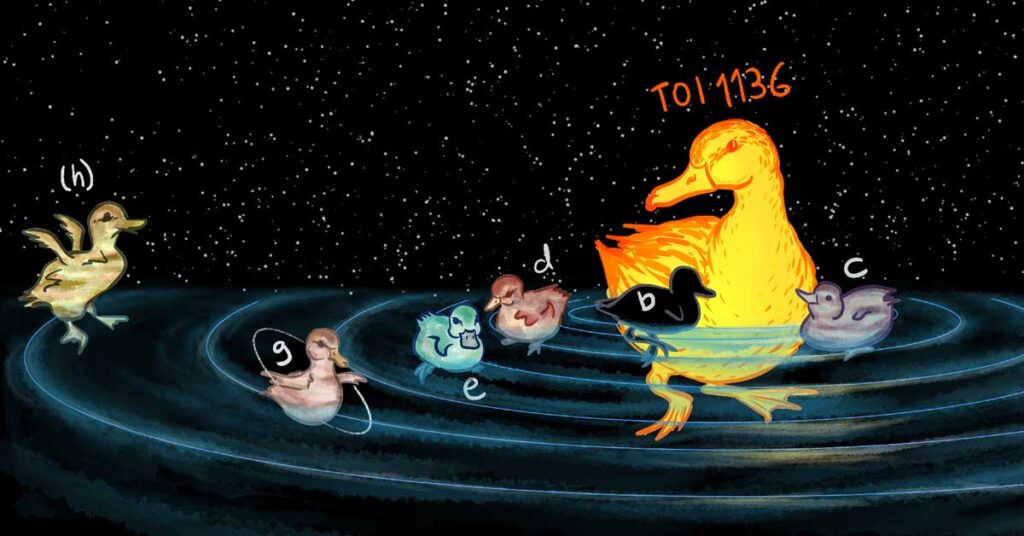A groundbreaking discovery in the realm of astronomy has unveiled a solar system brimming with intrigue, located over 270 light-years away.
This newfound system boasts six confirmed exoplanets, with tantalizing hints of a seventh world yet to be fully confirmed.
In a meticulous study led by researchers at the University of California, Irvine, utilizing a vast array of observatories and cutting-edge instruments, scientists have unveiled unprecedented insights into the formation and evolution of these distant planets.
Unraveling Mysteries with Precision Analysis
Published in The Astronomical Journal, the findings of the TESS-Keck Survey shed light on the exoplanetary dance around TOI-1136, a dwarf star residing within the Milky Way galaxy.
Leveraging data from the Transiting Exoplanet Survey Satellite (TESS), researchers meticulously measured the masses, orbital dynamics, and atmospheric properties of these celestial bodies.
Blending Techniques for Unprecedented Detail
Combining transit timing variation (TTV) data with radial velocity analysis, scientists delved deep into the nuances of this distant solar system.
Employing advanced instruments like the Automated Planet Finder telescope and the High-Resolution Echelle Spectrometer, subtle variations in stellar motion were discerned, paving the way for precise mass determinations.
Computational Mastery Unveils Planetary Secrets
Through intricate computer modeling, merging hundreds of radial velocity measurements with TTV data, the research team achieved a comprehensive understanding of the exoplanets’ characteristics.
Lead author Corey Beard highlighted the complexity of the endeavor, emphasizing the breakthrough achieved in unraveling the mysteries of this planetary system.
A Multitude of Worlds Beckons Further Inquiry
The abundance of planets orbiting TOI-1136 presents a unique opportunity for in-depth exploration.
Co-author Paul Robertson underscored the significance of studying multiple exoplanets within a single system, offering insights into the diverse mechanisms shaping planetary evolution.
Youthful Star, Cosmic Playground
At a mere 700 million years old, TOI-1136 stands as a youthful beacon in the cosmos.
Its dynamic nature poses challenges and opportunities for astronomers, with phenomena like magnetism and solar flares sculpting the planets’ atmospheres.
Sub-Neptunes: Unveiling Alien Worlds
TOI-1136’s confirmed exoplanets, dubbed “sub-Neptunes,” challenge conventional understanding with their unique characteristics.
These distant worlds, ranging in size from double to quadruple Earth’s radius, orbit their host star in orbits briefer than Mercury’s journey around the Sun.
A Symphony of Planetary Resonance
Adding to the intrigue is the potential existence of a seventh planet, hinted at by resonant forces within the system.
Robertson likened the orbital harmony to musical chords, suggesting both destabilizing and stabilizing effects on the planetary orbits.
Quest for Planetary Atmospheres Continues
While the survey has unveiled a wealth of information, it also ignites curiosity about the composition of these distant worlds’ atmospheres.
Researchers eagerly anticipate leveraging NASA’s James Webb Space Telescope for advanced spectroscopic analysis, poised to unlock further mysteries of this captivating solar system.
Beyond Science Fiction: Unveiling Cosmic Realities
Matthew Shetrone, deputy director of UC Observatories, expressed excitement about the implications of this discovery.
The prospect of encountering diverse planetary compositions within a single system tantalizes scientists, pushing the boundaries of our understanding of the cosmos.
As humanity peers deeper into the cosmos, each discovery unveils a tapestry of cosmic wonders, inviting us to contemplate the vastness and diversity of the universe.
FAQ
An exoplanet, short for “extrasolar planet,” is a planet that orbits a star outside of our solar system. These planets can vary greatly in size, composition, and orbit, and studying them provides valuable insights into planetary formation and the potential for habitability beyond Earth.
Exoplanets are detected using various methods, including the transit method, radial velocity method, direct imaging, microlensing, and astrometry. Each method relies on different techniques to observe the effects of planets on their parent stars or to directly capture images of these distant worlds.
Astronomers determine the properties of exoplanets, such as their mass, size, and atmosphere, through a combination of observational data and theoretical models. Techniques like transit photometry, radial velocity measurements, and spectroscopy provide valuable information about these distant worlds.
Sub-Neptunes are a class of exoplanets that have sizes between that of Earth and Neptune. They typically have rocky cores surrounded by thick atmospheres, although their exact compositions can vary. Studying sub-Neptunes helps scientists understand the diversity of planetary systems and the conditions necessary for planet formation.
Scientists search for habitable exoplanets by focusing on planets located within the “habitable zone” of their host stars. This zone refers to the range of distances where conditions may be suitable for liquid water to exist on the planet’s surface, a key ingredient for life as we know it.
More information: Corey Beard et al, The TESS-Keck Survey XVII: Precise Mass Measurements in a Young, High Multiplicity Transiting Planet System using Radial Velocities and Transit Timing Variations, arXiv (2023). DOI: 10.48550/arxiv.2312.04635


